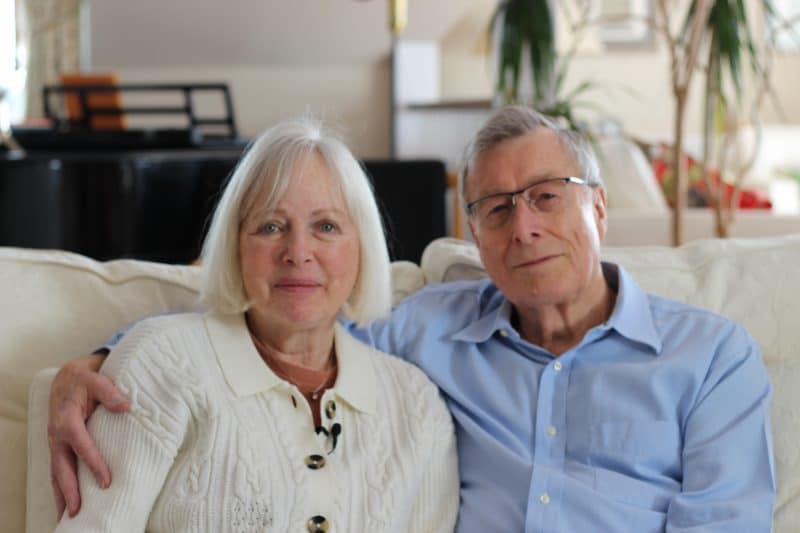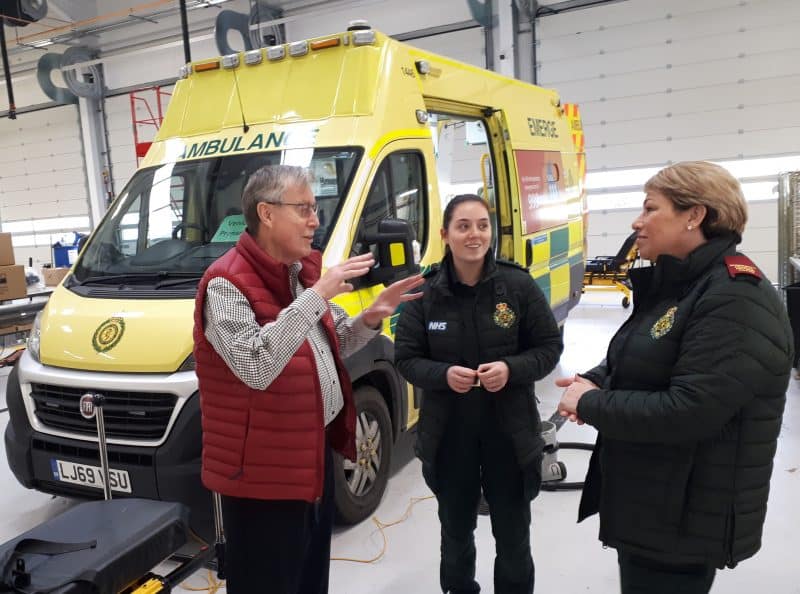
A Reigate man has leant his voice to calls for everyone to learn CPR (cardio-pulmonary resuscitation) after being reunited with some of the ambulance team who help save his life.
Michael Woolley, 80, suffered a cardiac arrest at his home on the afternoon of 14 December last year. His wife, Lynn, who joined him when he visited Banstead Make Ready Centre recently, immediately began CPR, called 999 and followed the instructions of Emergency Medical Advisor, Barbara Trevena.
First to arrive at the scene in around five minutes was paramedic Lucy Thomson. Lucy commenced advanced life support and began delivering shocks with a defibrillator to restart Michael’s heart, before being joined by paramedics, Tracey Little, Millie Lowe, on her first shift as a fully-qualified paramedic, and Critical Care Paramedic, Lee Davis.
Together the team delivered a total of eight shocks to establish a more normal rhythm for Michael’s heart as the Trust’s Hazardous Area Response Team, (HART), joined them at the scene to lead what was a challenging exit from the couple’s top floor apartment.
Michael was rushed to St George’s Hospital where he underwent an angioplasty procedure to open up his arteries. While initially given a further life-expectancy of just one to two years following his ordeal, Michael has since had an internal defibrillator fitted, increasing his life-expectancy by some five to 10 years.
“The day of my collapse was just miracle after miracle”, explained Michael. “First the fact that I wasn’t on my own in the lift when I collapsed but instead in front of Lynn, then that Lynn began CPR so expertly directed by Barbara and then that Lucy and her colleagues were so quickly with us ensuring I received the treatment I needed.
 “Everything just fitted together so perfectly. I’m so lucky to be here and so grateful to the whole team for everything they did for me. It was very emotional meeting everyone but I’m so happy I’ve had the opportunity to say thank you face-to-face.”
“Everything just fitted together so perfectly. I’m so lucky to be here and so grateful to the whole team for everything they did for me. It was very emotional meeting everyone but I’m so happy I’ve had the opportunity to say thank you face-to-face.”
Emergency Medical Advisor, Barbara, praised Lynn’s calmness as she gave CPR to Michael ahead of Lucy’s arrival. “Lynn did everything right,” she said. “It’s so vital that CPR is commenced straight away to give any patient the best chance of survival. Lynn was brilliant.”
The initial CPR and subsequent treatment was so beneficial, in fact, that hospital teams performed a second scan to check Michael’s brain when the first showed up so little damage had occurred.
 Lynn expressed her thanks to the clear instruction delivered by Barbara and added: “I will forever be grateful for how she talked me through everything I needed to do that day. She was a calming voice and I am so pleased to have been able to thank her and the whole team in person.”
Lynn expressed her thanks to the clear instruction delivered by Barbara and added: “I will forever be grateful for how she talked me through everything I needed to do that day. She was a calming voice and I am so pleased to have been able to thank her and the whole team in person.”
Lucy added: “It was a real team effort from start to finish. From the moment Lynn dialled 999 and begun CPR so quickly. It was the perfect example of the chain of survival. We were all delighted to meet Michael and Lynn under far better circumstances and we’re so pleased to play our part in ensuring Michael can look ahead to the future and enjoy life.”
Michael and Lynn have been together for more than 40 years and have two children, Lucia and Emma, who Michael is looking forward walking down the aisle next year.
Last month, SECAmb published its annual cardiac arrest report which revealed more than three-quarters of all resuscitations attempts undertaken by crews take place in the home.
The report, covering April 2021 to March 2022, also showed that SECAmb responded to 8,005 patients who had suffered a cardiac arrest and that it was viable to commence resuscitation of 2,788 patients.
Of the attempted resuscitations, a ‘Return of Spontaneous Circulation’ or ROSC was maintained to hospital 26 per cent of the time, while 11 per cent of patients (299 people) were alive 30 days after their cardiac arrest.
For more details visit Trust publishes cardiac arrest report and urges public to learn to save a life – NHS South East Coast Ambulance Service (secamb.nhs.uk)
The report is available to download in full here: Annual-Cardiac-Arrest-Report-FINAL.pdf (secamb.nhs.uk)
Further information on CPR available on the Resuscitation Council website: Home | Resuscitation Council UK
The Resuscitation Council has created a “CPQR code” – a heart shaped QR code that directs people to a short video on how to do CPR.
